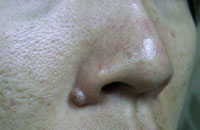Naevi are extremely common and all individuals have such blemishes on the skin. Some consult for cosmetic reasons or because they worry about their nature. Naevi are benign growth of any cells normally present in the skin. So there are a great varieties of them. An epidermal naevus is a benign growth of keratinocytes, and a melanocytic naevus is a benign growth of melanocytes, which is commonly referred to as a mole.
Melanocytic naevi can be present at birth or acquired in later life. There are different types of acquired melanocytic naevi:
Junctional naevus: the naevus cells are located at the junction between the epidermis and dermis. It is flat, appears brownish black.
Intradermal naevus: the naevus cells are located in the dermis only. They are raised and mostly flesh-coloured, although some can be pigmented.
Compound naevus: a mixture of junctional and intradermal proliferation. They are slightly raised and brownish black.
Blue naevus: it is blue in colour as the melanocytes are very deep in the dermis.
 |
 |
Melanocytic naevi are related to sun exposure and they are therefore much more common in fair-skinned individuals, while individuals with darker skin types might have fewer naevi because of the protective properties of melanin from sunlight exposure. They may also darken following sun exposure or during pregnancy
Melanocytic naevi are benign but can be found in association with melanoma. The true frequency of transforming into melanoma is not known. If there is any doubt about the appearance, particularly when there is a change of size, thickness, darkness etc, always consult a dermatologist who will be able to tell if there is any need for further investigation.
Those clinically benign naevi can be removed by simple excision but this is going to need suture with the result of a scar, which is cosmetically unacceptable, particularly on the face. The raised intradermal types can be dealt with by shaving using an electric cautery. Now the CO2 laser is used to remove any of these easily, leaving only a mark, which will subside in a matter of months, and no trace afterwards.

